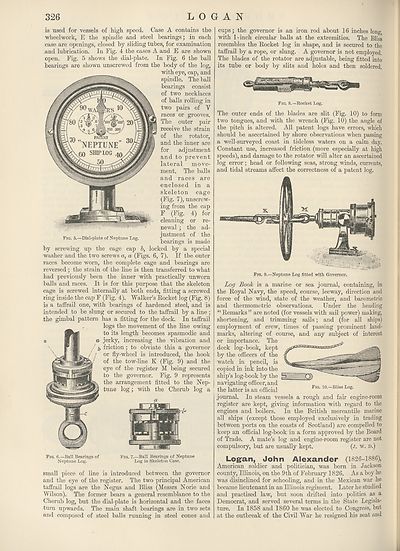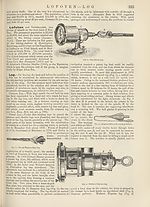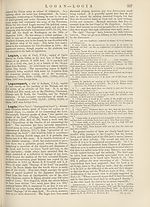New volumes of the Encyclopædia Britannica > Volume 30, K-MOR
(356) Page 326
Download files
Complete book:
Individual page:
Thumbnail gallery: Grid view | List view

326
LOGAN
is used for vessels of high speed. Case A contains the
wheelwork, E the spindle and steel bearings; in each
case are openings, closed by sliding tubes, for examination
and lubrication. In Fig. 4 the cases A and E are shown
open. Fig. 5 shows the dial-plate. In Fig. 6 the ball
bearings are shown unscrewed from the body of the log,
with eye, cap, and
spindle. The ball
bearings consist
of two necklaces
of balls rolling in
two pairs of V
races or grooves.
The outer pair
receive the strain
of the rotator,
and the inner are
for adjustment
and to prevent
lateral move¬
ment. The balls
and races are
enclosed in a
skeleton cage
(Fig. 7), unscrew¬
ing from the cap
F (Fig. 4) for
cleaning or re¬
newal ; the ad¬
justment of the
bearings is made
locked by a special
Fig. 5.—Dial-plate of Neptune Log.
by screwing up the cage cap
washer and the two screws a, a (Figs. 6, 7). If the outer
races become worn, the complete cage and bearings are
reversed • the strain of the line is then transferred to what
had previously been the inner with practically unworn
balls and races. It is for this purpose that the skeleton
cage is screwed internally at both ends, fitting a screwed
ring inside the cap F (Fig. 4). Walker’s Kocket log (Fig. 8)
is a taffrail one, with bearings of hardened steel, and is
intended to be slung or secured to the taffrail by a line;
the gimbal pattern has a fitting for the deck. In taffrail
logs the movement of the line owing
to its length becomes spasmodic and
jerky, increasing the vibration and
friction; to obviate this a governor
or fly-wheel is introduced, the hook
of the tow-line K (Fig. 9) and the
eye of the register M being secured
to the governor. Fig. 9 represents
the arrangement fitted to the Hep-
tune log; with the Cherub log a
cups; the governor is an iron rod about 16 inches long,
with 1-inch circular balls at the extremities. The Bliss
resembles the Rocket log in shape, and is secured to the
taffrail by a rope, or slung. A governor is not employed.
The blades of the rotator are adjustable, being fitted into
its tube or body by slits and holes and then soldered.
Fig. 8. —Rocket Log.
The outer ends of the blades are slit (Fig. 10) to form
two tongues, and with the wrench (Fig. 10) the angle of
the pitch is altered. All patent logs have errors, which
should be ascertained by shore observations when passing
a well-surveyed coast in tideless waters on a calm day.
Constant use, increased friction (more especially at high
speeds), and damage to the rotator will alter an ascertained
log error; head or following seas, strong winds, currents,
and tidal streams affect the correctness of a patent log.
Fig. 9.—Neptune Log fitted with Governor.
Log Book is a marine or sea journal, containing, in
the Royal Havy, the speed, course, leeway, direction and
force of the wind, state of the weather, and barometric
and thermometric observations. Under the heading
“ Remarks ” are noted (for vessels with sail power) making,
shortening, and trimming sails; and (for all ships)
employment of crew, times of passing prominent land¬
marks, altering of course, and any subject of interest
or importance. The
deck log-book, kept
by the officers of the
watch in pencil, is
copied in ink into the
ship’s log-book by the
navigating officer, and
the latter is an official
journal. In steam vessels a rough and fair engine-room
register are kept, giving information with regard to the
engines and boilers. In the British mercantile marine
all ships (except those employed exclusively in trading
between ports on the coasts of Scotland) are compelled to
keep an official log-book in a form approved by the Board
of Trade. A mate’s log and engine-room register are not
compulsory, but are usually kept. (j. w. D.)
Fig. 10.—Bliss Log.
Fig. 6.—Ball Bearings of Fig. 7.—Ball Bearings of Neptune
Neptune Log. Log in Skeleton Case.
small piece of line is introduced between the governor
and the eye of the register. The two principal American
taffrail logs are the Negus and Bliss (Messrs Norie and
Wilson). The former bears a general resemblance to the
Cherub log, but the dial-plate is horizontal and the faces
turn upwards. The main shaft bearings are in two sets
and composed of steel balls running in steel cones and
Logan, John Alexander (1826-1886),
American soldier and politician, was born in Jackson
county, Illinois, on the 9th of February 1826. As a boy he
was disinclined for schooling, and in the Mexican war he
became lieutenant in an Illinois regiment. Later he studied
and practised law, but soon drifted into politics as a
Democrat, and served several terms in the State Legisla¬
ture. In 1858 and 1860 he was elected to Congress, but
at the outbreak of the Civil War he resigned his seat and
LOGAN
is used for vessels of high speed. Case A contains the
wheelwork, E the spindle and steel bearings; in each
case are openings, closed by sliding tubes, for examination
and lubrication. In Fig. 4 the cases A and E are shown
open. Fig. 5 shows the dial-plate. In Fig. 6 the ball
bearings are shown unscrewed from the body of the log,
with eye, cap, and
spindle. The ball
bearings consist
of two necklaces
of balls rolling in
two pairs of V
races or grooves.
The outer pair
receive the strain
of the rotator,
and the inner are
for adjustment
and to prevent
lateral move¬
ment. The balls
and races are
enclosed in a
skeleton cage
(Fig. 7), unscrew¬
ing from the cap
F (Fig. 4) for
cleaning or re¬
newal ; the ad¬
justment of the
bearings is made
locked by a special
Fig. 5.—Dial-plate of Neptune Log.
by screwing up the cage cap
washer and the two screws a, a (Figs. 6, 7). If the outer
races become worn, the complete cage and bearings are
reversed • the strain of the line is then transferred to what
had previously been the inner with practically unworn
balls and races. It is for this purpose that the skeleton
cage is screwed internally at both ends, fitting a screwed
ring inside the cap F (Fig. 4). Walker’s Kocket log (Fig. 8)
is a taffrail one, with bearings of hardened steel, and is
intended to be slung or secured to the taffrail by a line;
the gimbal pattern has a fitting for the deck. In taffrail
logs the movement of the line owing
to its length becomes spasmodic and
jerky, increasing the vibration and
friction; to obviate this a governor
or fly-wheel is introduced, the hook
of the tow-line K (Fig. 9) and the
eye of the register M being secured
to the governor. Fig. 9 represents
the arrangement fitted to the Hep-
tune log; with the Cherub log a
cups; the governor is an iron rod about 16 inches long,
with 1-inch circular balls at the extremities. The Bliss
resembles the Rocket log in shape, and is secured to the
taffrail by a rope, or slung. A governor is not employed.
The blades of the rotator are adjustable, being fitted into
its tube or body by slits and holes and then soldered.
Fig. 8. —Rocket Log.
The outer ends of the blades are slit (Fig. 10) to form
two tongues, and with the wrench (Fig. 10) the angle of
the pitch is altered. All patent logs have errors, which
should be ascertained by shore observations when passing
a well-surveyed coast in tideless waters on a calm day.
Constant use, increased friction (more especially at high
speeds), and damage to the rotator will alter an ascertained
log error; head or following seas, strong winds, currents,
and tidal streams affect the correctness of a patent log.
Fig. 9.—Neptune Log fitted with Governor.
Log Book is a marine or sea journal, containing, in
the Royal Havy, the speed, course, leeway, direction and
force of the wind, state of the weather, and barometric
and thermometric observations. Under the heading
“ Remarks ” are noted (for vessels with sail power) making,
shortening, and trimming sails; and (for all ships)
employment of crew, times of passing prominent land¬
marks, altering of course, and any subject of interest
or importance. The
deck log-book, kept
by the officers of the
watch in pencil, is
copied in ink into the
ship’s log-book by the
navigating officer, and
the latter is an official
journal. In steam vessels a rough and fair engine-room
register are kept, giving information with regard to the
engines and boilers. In the British mercantile marine
all ships (except those employed exclusively in trading
between ports on the coasts of Scotland) are compelled to
keep an official log-book in a form approved by the Board
of Trade. A mate’s log and engine-room register are not
compulsory, but are usually kept. (j. w. D.)
Fig. 10.—Bliss Log.
Fig. 6.—Ball Bearings of Fig. 7.—Ball Bearings of Neptune
Neptune Log. Log in Skeleton Case.
small piece of line is introduced between the governor
and the eye of the register. The two principal American
taffrail logs are the Negus and Bliss (Messrs Norie and
Wilson). The former bears a general resemblance to the
Cherub log, but the dial-plate is horizontal and the faces
turn upwards. The main shaft bearings are in two sets
and composed of steel balls running in steel cones and
Logan, John Alexander (1826-1886),
American soldier and politician, was born in Jackson
county, Illinois, on the 9th of February 1826. As a boy he
was disinclined for schooling, and in the Mexican war he
became lieutenant in an Illinois regiment. Later he studied
and practised law, but soon drifted into politics as a
Democrat, and served several terms in the State Legisla¬
ture. In 1858 and 1860 he was elected to Congress, but
at the outbreak of the Civil War he resigned his seat and
Set display mode to:
![]() Universal Viewer |
Universal Viewer | ![]() Mirador |
Large image | Transcription
Mirador |
Large image | Transcription
Images and transcriptions on this page, including medium image downloads, may be used under the Creative Commons Attribution 4.0 International Licence unless otherwise stated. ![]()
| Encyclopaedia Britannica > New volumes of the Encyclopædia Britannica > Volume 30, K-MOR > (356) Page 326 |
|---|
| Permanent URL | https://digital.nls.uk/193572129 |
|---|
| Attribution and copyright: |
|
|---|---|
| Shelfmark | EB.18 |
|---|---|
| Description | Ten editions of 'Encyclopaedia Britannica', issued from 1768-1903, in 231 volumes. Originally issued in 100 weekly parts (3 volumes) between 1768 and 1771 by publishers: Colin Macfarquhar and Andrew Bell (Edinburgh); editor: William Smellie: engraver: Andrew Bell. Expanded editions in the 19th century featured more volumes and contributions from leading experts in their fields. Managed and published in Edinburgh up to the 9th edition (25 volumes, from 1875-1889); the 10th edition (1902-1903) re-issued the 9th edition, with 11 supplementary volumes. |
|---|---|
| Additional NLS resources: |
|

